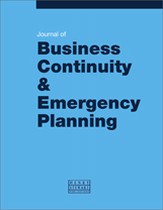The competing pressures paradigm: A tool for improving emergency and continuity planning efficacy?
Abstract
This paper introduces the competing pressures paradigm (CPP) — a conceptual model to improve the emergency and continuity planning process through enhanced organisational and societal pressure management. The CPP is a theory, a learning tool and a planner’s aide-memoire. It is designed to encourage critical reflection and proactive strategising to address five competing pressures in order to engender greater planning efficacy. Whereas planners typically focus on three core pressures — legislative compliance, organisational alignment (internal and external) and managerial preference — the CPP also focuses on two covert pressures, namely, usability and the needs of humanity and society. Accordingly, this paper explores all five of these constituent pressures to present a learning tool with both theoretical and practical applications for emergency and continuity management.
The full article is available to subscribers to the journal.
Author's Biography
Tony Mcaleavy has taught in the USA, the UK, the United Arab Emirates and Turkey. Dr McAleavy has broad emergency and continuity management experience as a coastguard and ambulance service officer, and local government civil contingencies manager. His teaching and research spans mitigation, preparedness, response and recovery with a core focus on command and control, and interoperability.
Citation
Mcaleavy, Tony (2020, March 1). The competing pressures paradigm: A tool for improving emergency and continuity planning efficacy?. In the Journal of Business Continuity & Emergency Planning, Volume 13, Issue 3. https://doi.org/10.69554/RKZS8562.Publications LLP
